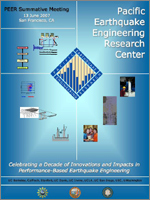PEER Summative Meeting
13 June 2007
Giannini Auditorium, Bank of America Building
555 California St., San Francisco, CA 94104
PEER Celebrates 10 Years of Funding by the NSF

Download brochure
(PDF file - 5.5 MB)In a joyous, day-long review of research and educational accomplishments, PEER celebrated ten years of funding by the National Science Foundation (NSF). An NSF site visit team, selected from the reviewers who have served on the span of reviews from start-up to the previous year, attended the meeting, gathering information on PEER's programs, and preparing to write a final report on NSF's investment in the PEER Program.
Themed "Celebrating a Decade of Innovations and Impacts in Performance-Based Earthquake Engineering," the presentations by PEER researchers and students were delivered in the festive surroundings of the Bank of America Building's Giannini Auditorium and elegant Carnelian Room/Bankers Club dining rooms featuring spectacular views of the city and San Francisco Bay.
The program recounted the formation of PEER, its development over the past decade, its major accomplishments and impacts, and future plans. It specifically covered research, education, and technology transfer successes, and involves several of PEER's key contributors.
According to PEER Director Jack Moehle, "When PEER started its program in 1997, performance-based earthquake engineering was in its first generation, often relying on prescriptive approaches that provided a nominal measure of expected performance. Since that time, PEER developed a more rigorous performance-based approach, with performance measured in systems-level metrics that matter to stakeholders. PEER also created simulation technologies, models and criteria to enable practical implementation of performance-based engineering approaches. Today, the impacts of PEER's research, education, and technology transfer programs can be found throughout the building, transportation, and utilities industries."
PEER's many ongoing contributors and Business and Industry Partners were especially recognized for investing in the Center and its mission to advance earthquake engineering. These strong relationships, Director Moehle emphasized, have positively effected seismic safety and set forth a model approach that will accelerate seismic safety developments in the future.
For those interested in seeing an overview of PEER's accomplishments, as well as future plans, PEER has drafted the first chapter of its final report, which can be downloaded by clicking here (PDF document - 3.2MB).
